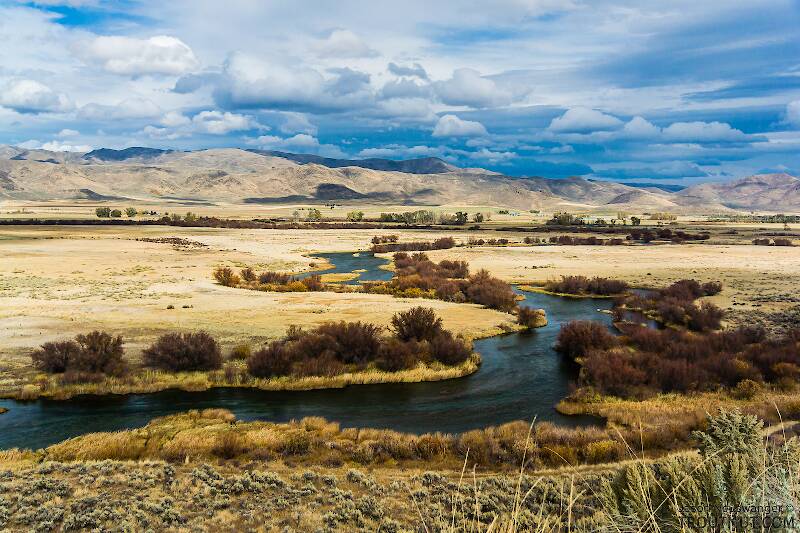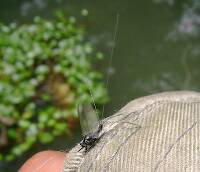
Salmonflies
Pteronarcys californica
The giant Salmonflies of the Western mountains are legendary for their proclivity to elicit consistent dry-fly action and ferocious strikes.
Featured on the forum

It's only barely visible in one of my pictures, but I confirmed under the microscope that this one has a prosternal horn and the antennae are mid-way between the eyes and front of the head capsule.
I'm calling this one Pycnopsyche, but it's a bit perplexing. It seems to key definitively to at least Couplet 8 of the Key to Genera of Limnephilidae Larvae. That narrows it down to three genera, and the case seems wrong for the other two. The case looks right for Pycnopsyche, and it fits one of the key characteristics: "Abdominal sternum II without chloride epithelium and abdominal segment IX with only single seta on each side of dorsal sclerite." However, the characteristic "metanotal sa1 sclerites not fused, although often contiguous" does not seem to fit well. Those sclerites sure look fused to me, although I can make out a thin groove in the touching halves in the anterior half under the microscope. Perhaps this is a regional variation.
The only species of Pycnopsyche documented in Washington state is Pycnopsyche guttifera, and the colors and markings around the head of this specimen seem to match very well a specimen of that species from Massachusetts on Bugguide. So I am placing it in that species for now.
Whatever species this is, I photographed another specimen of seemingly the same species from the same spot a couple months later.
I'm calling this one Pycnopsyche, but it's a bit perplexing. It seems to key definitively to at least Couplet 8 of the Key to Genera of Limnephilidae Larvae. That narrows it down to three genera, and the case seems wrong for the other two. The case looks right for Pycnopsyche, and it fits one of the key characteristics: "Abdominal sternum II without chloride epithelium and abdominal segment IX with only single seta on each side of dorsal sclerite." However, the characteristic "metanotal sa1 sclerites not fused, although often contiguous" does not seem to fit well. Those sclerites sure look fused to me, although I can make out a thin groove in the touching halves in the anterior half under the microscope. Perhaps this is a regional variation.
The only species of Pycnopsyche documented in Washington state is Pycnopsyche guttifera, and the colors and markings around the head of this specimen seem to match very well a specimen of that species from Massachusetts on Bugguide. So I am placing it in that species for now.
Whatever species this is, I photographed another specimen of seemingly the same species from the same spot a couple months later.

Troutnut is a project started in 2003 by salmonid ecologist Jason "Troutnut" Neuswanger to help anglers and
fly tyers unabashedly embrace the entomological side of the sport. Learn more about Troutnut or
support the project for an enhanced experience here.
CharlieSawd on May 22, 2009May 22nd, 2009, 12:33 pm EDT
I am curious if any of you have come across any literature, or know personally why dry conditions (low precipitation and stream level) affect mayfly and caddis hatches. At first, the answer may seem intuitive, but upon further scrutiny, I am finding that is not the case.
Any help would be appreciated.
Thanks,
Any help would be appreciated.
Thanks,
Charlie Sawdey
www.driftlessflybox.com
www.driftlessflybox.com
Willmilne on May 22, 2009May 22nd, 2009, 12:57 pm EDT
Hi
This paper dicusses diversity and densities in an unstable stream environment
http://www.famu.org/mayfly/pubs/pub_f/pubflannaganj1991p333.pdf[
and this one has some interesting data regarding flow variations and emergence densities
http://www.famu.org/mayfly/pubs/pub_f/pubflannagaj2001p97.pdf
hope that helps
Will
This paper dicusses diversity and densities in an unstable stream environment
http://www.famu.org/mayfly/pubs/pub_f/pubflannaganj1991p333.pdf[
and this one has some interesting data regarding flow variations and emergence densities
http://www.famu.org/mayfly/pubs/pub_f/pubflannagaj2001p97.pdf
hope that helps
Will
Konchu on May 22, 2009May 22nd, 2009, 2:38 pm EDT
That IS a deceptively difficult question to answer. Here's a few thoughts and observations. No more than that.
Several local insect species develop much more quickly when the water levels drop and flow slows. One part of this is that the stream temperature increases and so does the metabolism of the bugs.
In a nearby stream that I visited about an hour ago, for example, the insects are developing pretty quickly now. We had near flood conditions about a week ago, but the stream has dried to a mere trickle this weekend. The populations of bugs are really concentrated, and I'm guessing they'll pop out any day, if they haven't already started.
I saw some fish rising and kissing the water's surface. I heard even more of this from nearby pools.
Several local insect species develop much more quickly when the water levels drop and flow slows. One part of this is that the stream temperature increases and so does the metabolism of the bugs.
In a nearby stream that I visited about an hour ago, for example, the insects are developing pretty quickly now. We had near flood conditions about a week ago, but the stream has dried to a mere trickle this weekend. The populations of bugs are really concentrated, and I'm guessing they'll pop out any day, if they haven't already started.
I saw some fish rising and kissing the water's surface. I heard even more of this from nearby pools.
Quick Reply
Related Discussions
Topic
Replies
Last Reply
28
Nov 24, 2015
by Martinlf
by Martinlf
3
Jul 10, 2011
by Entoman
by Entoman



